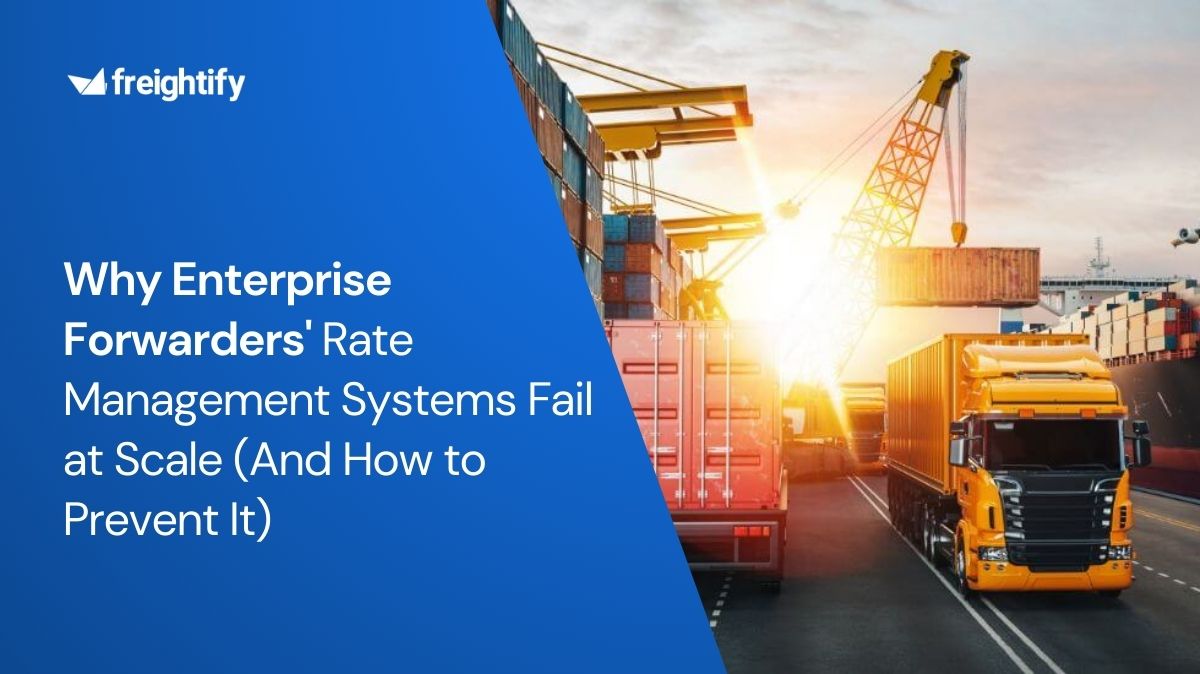The freight forwarding business depends on relationships and networking across the logistics industry.
With the onset of technological advancements, traditional methods and a limited customer base might not hold strong in a highly competitive and collaborative global industry. Technology has evolved, and so must the freight forwarder.
A sales executive within this $180.66 billion industry is expected to have hundreds of contacts at his fingertips.
This article delves into the current difficulties they face while pitching for business in a non-digitalized world. It also explores the major cloud / IoT -enabled platforms that a forwarding sales executive can rely on during this process.
What does the traditional freight forwarding process look like? A sales executive or forwarding agent in a traditional freight forwarding business model is expected to spend considerable time in the field. They set out at the start of the day to visit potential customers and understand their shipping requirements. On average, they could visit anywhere between seven to ten prospective customers during this period.
A customer at this stage would generally share information like the type of cargo, origin and destination ports, and the cargo dimensions. Once they have everyone’s inquiries, they return to the forwarding office, where they liaison with the pricing team to identify the schedules and market rates for each requirement.
The pricing team would then refer to complex rate sheets that contain worldwide shipping rates and schedules. If this main sheet is not up to date, the back-end team will manually call the liners to get their quotes and schedules.
In addition to this, the pricing team will also do a manual lookup for all the online/SPOT rates available by visiting several liners' websites one by one.
Once the rates are identified, the sales executive manually prepares the quotation, including the base shipping rate, additional charges, and other important terms and conditions.
Manually creating a quotation could take around six to seven hours. Additionally, when the quote reaches the prospective customer, it would be approximately 24 hours since the original inquiry came in.
Let us help you with your journey
Procure, Manage and Quote freight prices (with ancillary charges) in under 2 minutes!
What does the future of the freight forwarding industry look like? When discussing why a forwarding agent is unproductive in the traditional ecosystem, it is imperative to understand that the current supply chain market is known for being swift, scalable, competitive, and ultimately transparent.
The heightened competition in the freighting world does not make it easy for a forwarding salesperson to make a pitch and convert the order. There has been a 2.6% increase in new freight forwarding businesses in the US last year. Currently, no forwarding business holds over 5% of the market share , making this industry highly ambitious and aggressive.
Digital Solutions for freight forwarders to increase productivity 1. Centralized rate management system The bread and butter of the freight forwarding business stem from negotiating the best rates for a client.
With technical advancements like cloud computing and the IoT, the centralized rate management system (RMS) and the rate procurement tool eliminate the erstwhile time-consuming and labor intensive process.
A typical RMS tool assists freight forwarders in consolidating, optimizing, and streamlining the flow of contracts and live rates coming in from various shipping lines.
Carriers of all statures are equally featured on the tool, SMBs alongside large transporters like Maersk and CMA CGM, maintaining a balanced multi-carrier image.
The RMS solution offers coverage, ease of use, transparency, visibility, privacy, and speed. It is flexible, scalable, and allows for integration with other ERPs.
The biggest advantages of this include saving time & communication costs and enhanced efficiency within all internal departments.
The resultant impact of an improved workflow is quicker response times, securing lower costs, and retaining customers.
2. Centralized schedule visibility software Clients depend on the expertise of their forwarders to identify the best route, vessel type, and sometimes even the best packaging requirements.
Forwarders would hence require access to various scheduling information included in the rate management or the rate procurement systems, as well as the visibility software.
The rate procurement tool has direct integration with the carrier’s websites, providing information about the shipping route, origin, destination, estimated timings, availability of space, and the ship’s features.
Further, the addition of track and trace software allows the freight forwarder to continue being an expert point of contact for the client until the goods reach the destination port.
The track and trace tool allows cargo to be tracked based on container number or the MBL / HBL number. Automatic notifications can be enabled when the cargo achieves a particular milestone. Freightify offers tracking data on 90% of the ocean carriers.
3. Instant quotes generator Freightify offers an automated software solution that helps forwarder agents and sales individuals to create quotes without much internal intervention.
Research shows that the quote acceptance rate in a manual world is less than 10%. Conversely, instant quotes offer 100% accuracy and almost always lead to a converted inquiry.
With a complete overview of live rates and schedules, the sales staff can instantly compare and compile the quotation, add margins, and digitally share the quotation.
Freightify’s Instant Quotation Module allows forwarders to create a quote digitally in three quick and easy steps.
A single exhaustive database is used to trace and monitor schedules and rates across the global carriers. Keeping the customer inquiry as the base, the sales team can draw up the quotation within this larger database, ensuring zero misquotes.
Markups can be applied as whole values or in percentages. Furthermore, default markup addition rules can be set on the basis of trade route, liner, charge group, charge, and equipment types.
What are the pain points that freight forwarders face with traditional freight forwarding process? A forwarding agent is expected to spend hours at the client site without ready information that can help quick decision-making. They rely on the pricing team (based at a central office location) to understand the prevailing spot rates for any inquiry.
A customer expects the freight forwarder to stay connected at every step, navigating the uncertainties until the cargo reaches the destination. However, if a forwarding agent remains dependent on a third person for the data that the client requires, his role of being a market expert is ineffective and unsuccessful.
The delay in providing information (from price ranges to possible schedules) or the delay in sharing quotes could also result in the inaccuracy of the data relayed. Mistakes in quotes are common when additional human intervention is involved.
Moreover, this market is incredibly time-sensitive. As a result, forwarding agents are stuck repeating the process as by the time they share the initial information, it’s no longer valid.
If forwarders were to share obsolete details, a customer would not trust the process. It becomes challenging to retain clients, especially when a competitor can provide the right information.
In simple words: the difficulties that a freight forwarding salesperson faces can be split into two main topics:
The lack of data and the delay in communication.
Both issues raise concerns about effectively adding value for a client, eventually leading to customer attrition.
As a result, a forwarding business will have to re-engineer its operations to mirror the agile features of the global freight industry.
How can freight forwarders increase the efficacy of their sales? In futuristic research conducted by PwC, it was evident that 50% of the responders considered the lack of digital culture and training as the biggest challenge facing transportation and logistics companies.
Besides the worry that implementing digital solutions requires high investments, logistics leaders do not have a clear vision of how digitalization can be fruitful.
The survey continues to quote that
“‘Digital fitness’ will be a prerequisite for success: the winners will be those who understand how to exploit a whole range of new technologies, from data analytics to automation and platform solutions.” As explained in this Deloitte publication , typically, the involvement of multiple stakeholders and the requirement for customization hinder the digitization initiative. An additional concern is the lack of talent to understand new technologies and their impact on the forwarding business.
Freightify attempts to use the commonly recognized ideologies of visibility and transparency to eradicate these problems with their digital forwarding solutions.
Having instant visibility over rates, schedules, and cargo location can change the entire freight forwarding ecosystem. The timely information that digitalization brings in will help a freight forwarder add value to the customers – thereby strengthening the relationship and contributing to their growth.
Imagine having immediate insights on how to group multiple shipments to reduce the costs or information on routes with lesser shipping surcharges. This would constitute expert advice and could help propel the sales team towards securing a pitch.
How does the Freightify suite facilitate the forwarding sales team? Cloud technology has allowed for a new concept called ‘virtual freight forwarding.’ The benefit of a digital world provides speed, flexibility, scalability, and standardized and harmonized processes across the whole organization.
In a highly volatile supply chain industry, forwarders need to equip themselves with digital tools that can allow them to remain agile.
The Freightify suite of solutions banks on the concept of a single database that keeps data private, clean, and up to date. This relevant data is then translated into information that can win business.
Along with Data Analysis and API Integration capabilities, Freightify aims to re-engineer how freight forwarders conduct their operations.




















